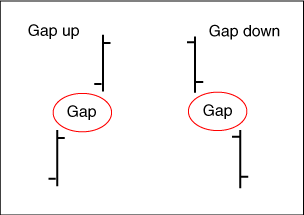Leading To Higher Prices?
Laps And Gaps To Get Your Edge
When a stock gaps higher at the open on bullish news, will that lead to even higher prices?
When a stock gaps higher at the open on bullish news, will that lead to even higher prices? This is the question that many traders ask before the market opens. You watch the financial news in the morning and hear a list of stocks set to open higher due to positive news overnight. Then you see a live report from the floor of the exchange that shows traders gathered around the post where XYZ stock is traded. You're told that stock is due to open 10% higher from the previous day's close. And it's all accompanied by a great story. If you already own it, you're probably thinking you couldn't ask for better news. And if you don't own XYZ, you may be wondering if you should buy the stock. Butů
In the final minutes before opening bell, you begin to recall instances in which stocks like this one actually closed lower by the end of the day. How that is possible with such bullish news?
QUICK REVIEW OF LAPS AND GAPS
Recently, we conducted new quantitative research on laps and gaps. We looked at the relationship between a stock's opening price and closing price on the previous day. To draw valid conclusions, we analyzed more than seven million trades from January 1, 1995, to June 30, 2006. We applied a price and liquidity filter that required all stocks be priced above $5 and have a 100-day moving average of volume greater than 250,000 shares. In doing so, we were able to provide traders with information that effectively removed much of the guesswork and uncertainty that gap openings often bring.
When gaps occur and you want to take action, the information in this article will help you make your decisions. While we cannot guarantee you will have a favorable outcome, you will know when there is a statistical edge based upon thousands of outcomes of previous gap openings from the past.
Most readers will probably be familiar with what gaps and laps are, but just to make sure, here's a quick description of these trading patterns. A "gap up" occurs when a stock's opening price is above the previous day's high and a "gap down" occurs when a stock opens below the previous day's low (see Figure 1). A "lap up" occurs when a stock's opening price is above the previous day's close, and a "lap down" occurs when a stock opens below the previous day's close (see Figure 2).

FIGURE 1: GAP UP AND GAP DOWN. When the opening price is above the previous day's high it is known as a gap up. When the opening price is below the previous day's high it is known as a gap down.
Many times, a "gap up" in a stock coincides with bullish news, such as a positive earnings surprise, analyst upgrade, the announcement of a hot new product, or a takeover rumor. Such financial news announcements are often accompanied by an interview of an analyst who talks about how the future is bright for the stock, and how prices are likely to push higher. While opinions like these often lead traders to make emotional decisions in the heat of the battle, they are rarely supported by any quantitative research.
...Continued in the July issue of Technical Analysis of STOCKS &
COMMODITIES
Excerpted from an article originally published in the July 2007 issue
of Technical Analysis of
STOCKS & COMMODITIES magazine. All rights reserved. © Copyright
2007, Technical Analysis, Inc.
Return to July 2007 Contents